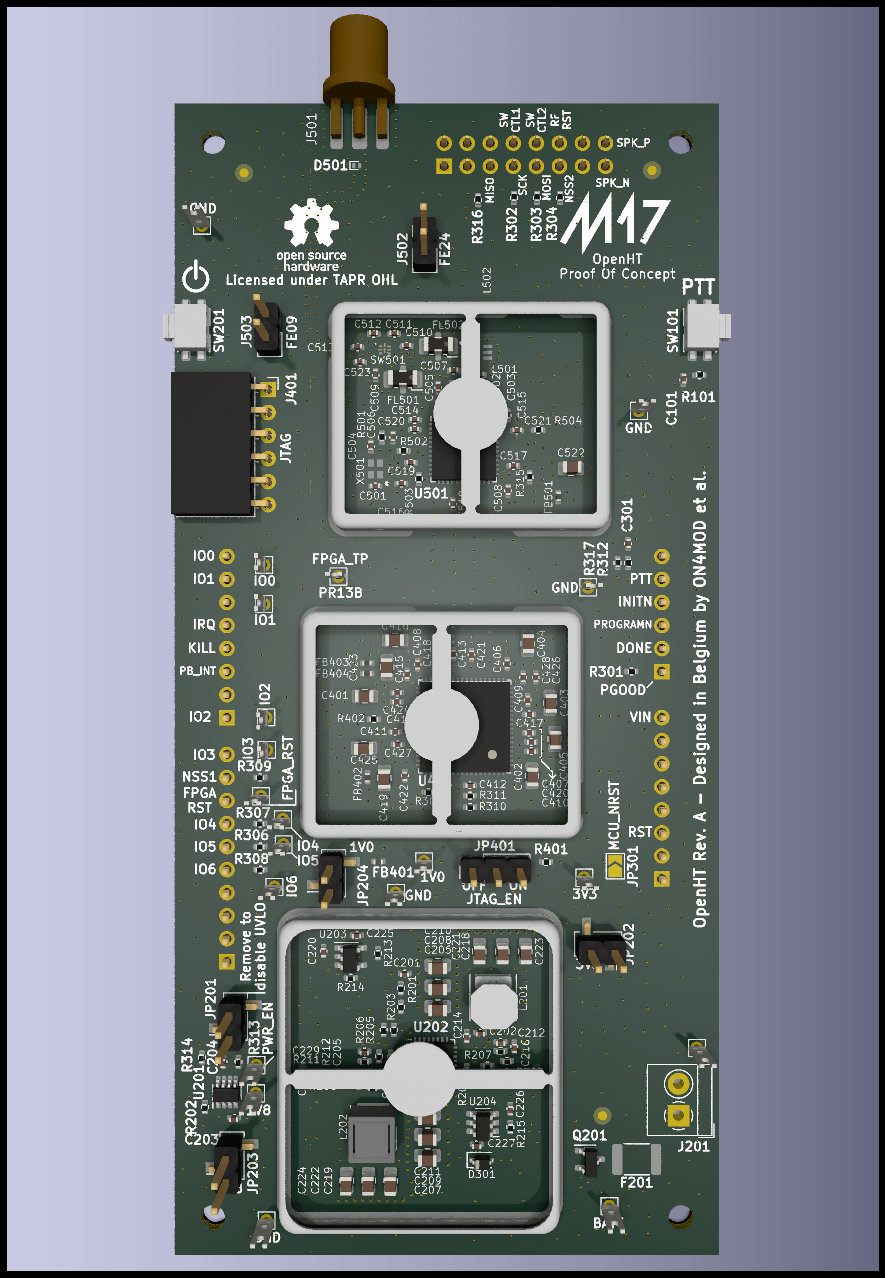Originally posted on Reddit r/hamdevs "one month ago" by Wojciech Kaczmarski. Link
Hi Reddit!
This is Woj from the M17 Project. We are about to finish the design of our new handheld transceiver, a TR-9 successor, the OpenHT. I'm sure some of you still remember our first attempt that didn't really take off (due to some f-ups in the RF PA design etc. - mea culpa). Well, we didn't give up and are still in business. As the protocol is mature and sees a lot of implementations worldwide, we decided to focus on the handheld radio. In the meantime, we are also working on a new revision of the Module17 modem board, so stay tuned. We hope to have both designs ready before HAM Radio Friedrichshafen (Germany, June 23-25), where we want to showcase them.
 OpenHT - Proof of Concept - an F469I-DISCO shield
OpenHT - Proof of Concept - an F469I-DISCO shield
The OpenHT, at least in its Proof of Concept stage, is a complete QRP SDR handheld transceiver. It's built around the STM32F469I-DISCO board. Morgan ON4MOD designed an awesome RF shield for it. Some technical details behind the design:
duobander: 389.5 - 480, 2400 - 2483.5MHz (RX, TX frequency ranges are limited by your local laws) low RF power output: <14dBm (<25mW) complete I/Q transceiver allowing for virtually any mode (including M17 and FreeDV) the radio uses the AT86RF215 low-cost I/Q transceiver chip by Microchip/Atmel use of an FPGA (Lattice LIFCL-40) as the AT86<->STM32 interface allows to offload the MCU (FPGA does the DSP heavylifting, all the way from RF stream to baseband) the radio will run a port of OpenRTX on it hardware is TAPR licensed Supported modes so far
Analog: FM, AM, SSB, OOK (CW) Digital: M17, FreeDV, crude "4FSK", SSTV, 16QAM, BPSK/QPSK/DQPSK, OFDM, AFSK, APRS Github repos:
RF board design: https://github.com/M17-Project/OpenHT-hw FPGA VHDL code: https://github.com/M17-Project/OpenHT-fpga firmware for the DISCO board: https://github.com/M17-Project/OpenHT-fw-test The project is being documented on YouTube, follow the M17 Project's channel: https://www.youtube.com/@M17Project/featured (see the OpenHT playlist).
All questions are welcome! The project will be developed further, expanding the device's capabilities. We'd like to thank Amateur Radio Digital Communications for making this - all M17-related goodies - possible!
EDIT: Our homepage is at https://m17project.org. We have Matrix/Discord chats linked together: https://m17project.org/get-started/community
Notable later discussions on this post:
C. Why the 2.4 band? For wifi?
R. It's an amateur band like any other. As an example, in IARU region 1 it can be used for FreeDV transmissions at QO-100 uplink frequencies.
C. If this also had support for the 2M band it could be the perfect HT :O
R. It's still in development, so it might have it some day.
C. Please explain this to me as if I’m your grandmother :/
R. (kc3svj) OpenHT is a small radio that you can hold in your hand. The team is designing it as a successor to a previous model called TR-9.
The OpenHT radio is being designed to work on different frequencies, but the specific frequencies you can use may be limited by local laws.
The radio has low power output, which means it doesn't transmit at a very high power level. It can work with different modes of communication, like talking in a regular voice (analog modes) or using digital modes that allow for more advanced features.
The OpenHT radio uses special chips and technology to process and transmit signals. It runs a software called OpenRTX, and the hardware design is licensed by TAPR.
If you're interested in the technical details and want to see the designs and software, you can find them on GitHub. The project is also being documented on YouTube.
The team is planning to keep developing the radio and adding more features.
C. (brovary3154) I hate to be a negative nellie, because I admire what the M17 project is trying to do. However, till this or really any radio can do several watts (not mili-watts), it's not really much to write home about. And I say that because filtering is the very-very hard part, and as the output power increases so does all the junk/ spurs etc. Once you have that, you have mastered it. Right now your at the hotspot lower level and thus the garbage negligible.
R. We had to start with something. At the M17 Project, we are very serious about what we offer to the amateur radio community. It's not likely that you will see a [WIP] tag indefinitely here.
After we are done with the "test drive", we can start worrying about things like the RF amp, spurs or adding GNSS/WiFi/BT modules.
Lastly - don't forget that our work is mostly based on volunteering. It usually takes some time to finish certain tasks.
...
Content by Wojciech Kaczmarski SP5WWP
Reposted / formatted by Steve Stroh N8GNJ
.jpg)